 Game designers are no stranger to repurposing mechanics from very old games. Bruno Cathala did it with his award-winning 5 Tribes (Mancala), and Antoine Bauza did it with Samurai Spirit (Blackjack). Well Mr. Cathala has once again dipped into the annals of gaming mechanics and emerged with Kingdomino, a game that seems to be clearly based on the age-old game of Dominos (the tile laying version, not the set-them-up-and-knock-them-down version). Was this another success? Let’s find out.
Game designers are no stranger to repurposing mechanics from very old games. Bruno Cathala did it with his award-winning 5 Tribes (Mancala), and Antoine Bauza did it with Samurai Spirit (Blackjack). Well Mr. Cathala has once again dipped into the annals of gaming mechanics and emerged with Kingdomino, a game that seems to be clearly based on the age-old game of Dominos (the tile laying version, not the set-them-up-and-knock-them-down version). Was this another success? Let’s find out.
Kingdomino is a tile laying game for 2-4 players that takes about 15 minutes to play. Kingdomino plays best with 2 or 4 players.
Game Overview:
In Kingdomino, players are seeking to expand their kingdom over the course of the game. Each round, players will be drafting colored tiles, and adding them to their existing territory using a simple tile-laying mechanic. Scoring is based on the size of each area, multiplied by any crown symbols present.
Game Components:
For such a small and inexpensive game, publisher Blue Orange Game did a great job putting together Kingdomino. Each of the kingdom tiles are beautifully illustrated to depict a top down view of your kingdom. Many tiles also contain small, extraneous illustrations that help keep the artwork engaging. I should also note that the tiles are made out of a really nice, thick cardboard. The rest of the components, from the cardboard castles to the custom shaped meeples are equally well produced.
How to Play:
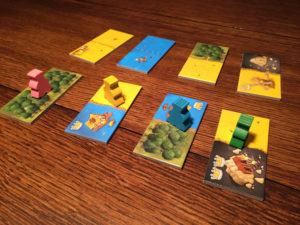
Learning to play Kingdomino is a breeze. Each round, there will be 2 sets of Kingdom tiles dealt out. For the first round, each players’ meeple is randomly placed on a tile in one set.
Turn order in a round changes based on which tile a player’s meeple is on. The lower number tiles always play before the higher numbers.
On a players turn, they take the tile their meeple is on and add it to their kingdom. There are a few placement rules.
Each new tile must:
- Connect to a previously played tile
- Be placed adjacent to a matching terrain type on at least on half of the tile (the starting tile counts as a wild)
- Not cause your kingdom to exceed a 5×5 grid.
Finally, the player places their meeple on a tile on the second set of tiles, claiming that for the next round. Once all the tiles for that round have been placed, a new set of tiles is dealt out and the game continues.
A game of Kingdomino lasts for 12 rounds. Each player calculates their score by counting up the amount of continuous squares in each terrain type, and multiplying that by the number of crowns showing in that area. The player with the most points wins.
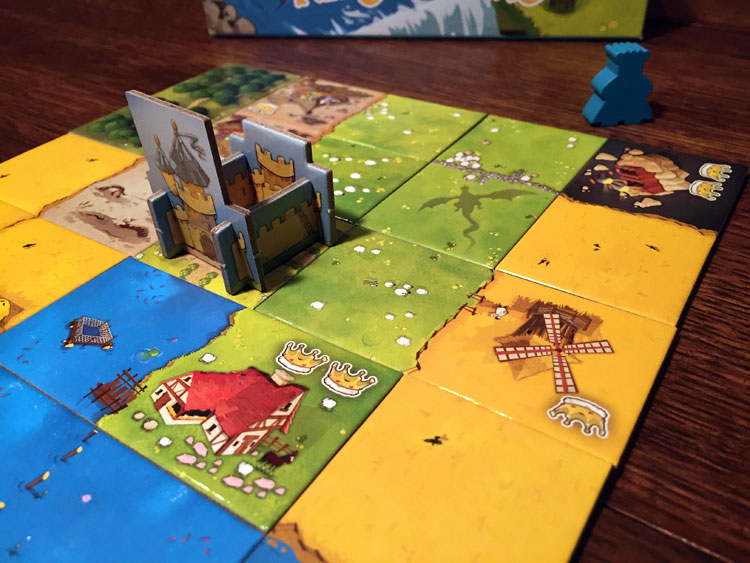
Game Experience:
Kingdomino was recently nominated for the Spiel des Jahres award and, after playing it, it’s not hard to see why. The rules in Kingdomino are incredibly accessible and this is definitely a game that can be played with just about anyone. I’ve trotted this one out both with my regular gaming group, and also friends who have barely scratched the surface of modern board games. And in each case, everyone has had a great time.
And that’s one of the reasons that I think Kingdomino makes a perfect gateway game. I haven’t met anyone yet that hasn’t picked up the rules right away. And with a play time of only 15 minutes, it hits that sweet spot where it can be used as a filler game while waiting for other players to show up to a game night.
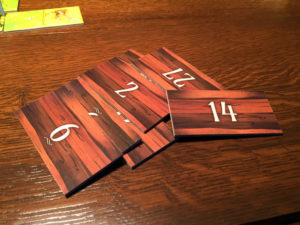
Yet as simple as Kingdomino is to learn, there is actually a little more depth then I expected. I’ve found that Kingdomino actually offers some strategic choices. Since turn order is decided by which tile you select, you really have to think about what you want to take for next round. While that last tile with the 3 crowns may be super tempting, it also means you are picking last in the following round, which could hurt if that tile you’ve really been waiting for pops up. It’s an interesting balancing act between grabbing the lucrative tile with a high number, and setting yourself up for next round.
However, one area where Kingdomino falters has to be at its 3 player count. The game works great with 2 and 4 players, but with only 3, you have to pull a set amount of tiles out at the start of the game. This could mean that terrain features you are building around might never show up in the game (and you have no way of knowing). So you could build out a massive forest, and only one crown might ever show up in a forest, which would be extremely frustrating. With 4 players you use all the tiles, and the two player game has an optional rule (a good one in my opinion) to use all the tiles and build a 7×7 grid.
Speaking of the optional rules, Kingdomino does include a few to help add some variety or complexity. I’m glad they did this as it will help keep the game coming to the table even when I’m not looking for a gateway game. Yet I already find myself looking forward to an expansion to add some more in-depth scoring opportunities. As much as I love how accessible the game is, I’d be ok if it had a bit more meat.
Final Thoughts:
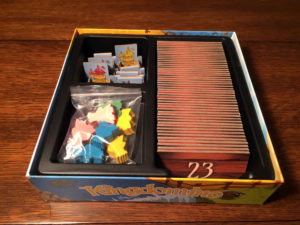
I’ve always been a big fan of tile laying games. From cutting my teeth early on in Carcassonne, to newer far like Karuba, I get an intense satisfaction of watching something be built before my eyes. So I’m not surprised that I enjoyed Kingdomino so much. It plays quick, looks great, and I’ve been able to bring it to the table with just about everyone so far.
While I do wish the three player rules were better, the rest of the game is really solid. I definitely think designer Bruno Cathaha has another hit on his hands here and I wouldn’t be surprised if Kingdomino ends up winning the Spiel des Jahres. This one will be staying in my collection and hopefully publisher Blue Orange Games will listen to my plea for an expansion!
If you’d like to pick up a copy of Kingdomino, you can get it for about $20.
Final Score: 4 Stars – A solid and accessible tile-laying game that looks great and plays quickly.
 Hits:
Hits:
• Easy to learn rules
• Great components
• Quick play time
• Variant rules for added variety
Misses:
• Playing with 3 isn’t great







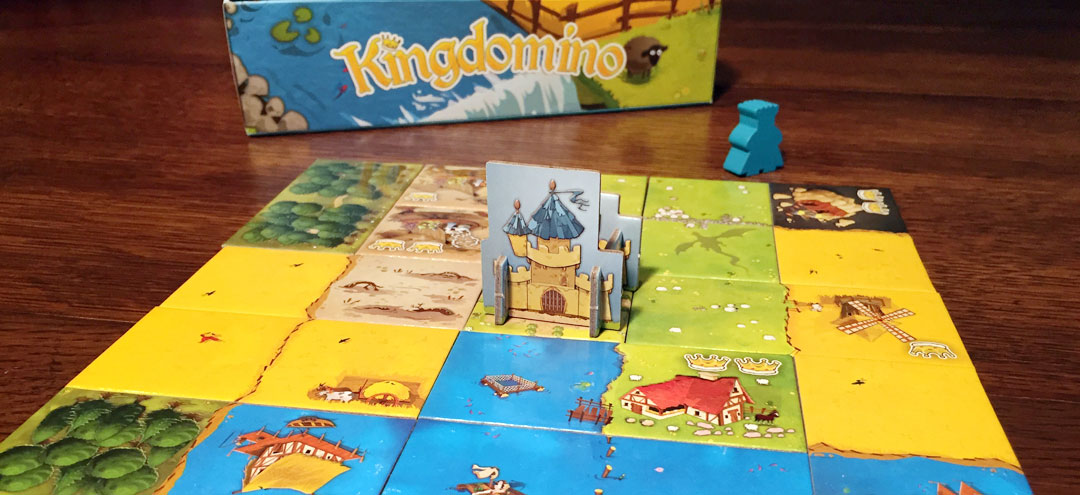















Great review of a nice game. Played it twice, once with 4 and once with 3. Definitely agree that it was way better with 4 players. I fell victim to that lack-of-crowns pitfall in the 3-player game, which really hampered my scoring potential.